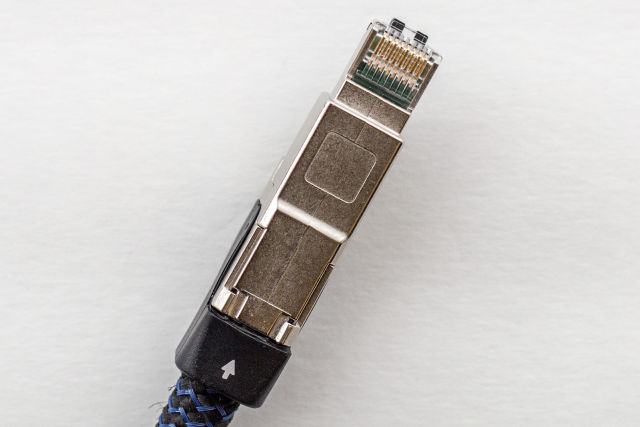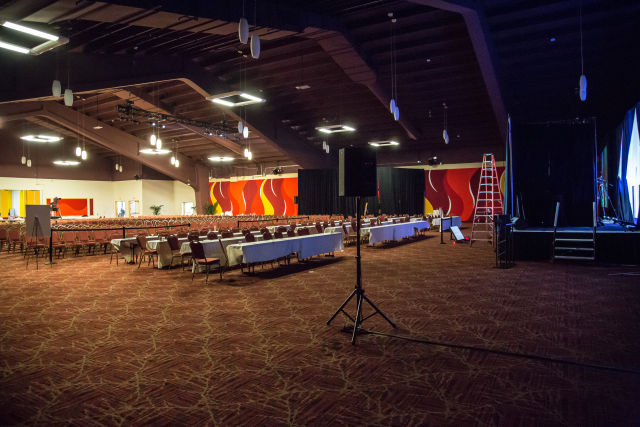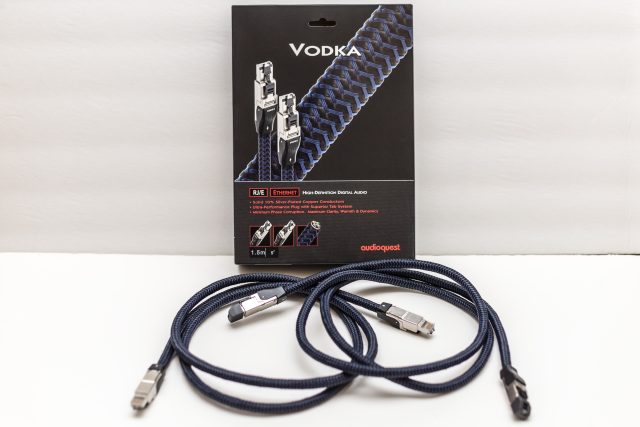 says manufacturer AudioQuest. "For best results have the arrow pointing in the direction of the flow of music. For example, NAS to Router, Router to Network Player.""/>
says manufacturer AudioQuest. "For best results have the arrow pointing in the direction of the flow of music. For example, NAS to Router, Router to Network Player.""/>
"Vegas again," I thought, as the noisy A320 plonked down onto the runway at McCarran. I was in the front, thanks to a plethora of reward miles on United, and across the row through the portal I could see the Vegas Strip—hungry, pulsing. It was only a few months since I'd last been here for CES, and coming back to the city felt a lot like putting back on that dirty, comfortable sweater you just can't seem to bring yourself to throw away.
But this time I wasn't here to report on gadgets or meet vendors or anything else quite like I'd done before—this time, I was going up on stage myself. After calling out the audiophile cable gods, I'd come to settle the score. I'd brought a $340 "audiophile grade" Ethernet cable, and I was ready to put it to the test with the assistance of the James Randi Educational Foundation in front of a live audience of several hundred people.
My room was waiting for me at the Mandalay Bay hotel—the very first place I'd ever stayed in Vegas on my very first conference back in 2003 and the place that always springs to mind before anything else when I think of the city. After taxiing to the lobby, the place even smelled the same: fresh, in a vaguely artificial floral way. I'd sleep, and then I'd sing and dance up on stage. The goal was to find out if a $340 Ethernet cable made any difference when you're using it to connect a computer to a NAS on which music was stored. To all common sense and science, the answer was "no," but that hasn't stopped a certain subset of audiophiles from believing in them—and from other silliness like decrying the efficacy of the scientific method when it comes to audio testing.
Did it or didn't it
Let’s get this out of the way first: the overwhelming majority of subjects could not tell the difference between a $350 AudioQuest Vodka Ethernet cable and a $2.50 "Cable Matters" cable from Amazon under our specific testing conditions. I don’t think anyone was expecting anything different from this test, including the true believer audiophile set. However, it’s possible that our test didn't account for some variables—which means, at worst, our results aren’t broadly applicable.
Let’s backtrack, though, and set the stage here before we dive into how it all went down. As we noted last week, this all happened at the James Randi Educational Foundation’s "The Amazing Meeting" conference in Las Vegas. The claim being examined was that when connected between a computer and an Ethernet switch while listening to music hosted on a NAS, the cables produce changes to the quality of music that are, in the words of reviewer Michael Lavorgna, "not subtle or slight" and "as plain as day."
Ars partnered with the James Randi Educational Foundation to test the cables on the basis of the JREF’s long history of conducting controlled tests with clearly defined methods and protocols on supposedly otherworldly phenomena. Famously, Randi and his team have been instrumental in debunking alleged psychics like Uri Geller and James Hydrick, along with faith healers like Peter Popoff; the group seemed to be a natural fit for plumbing the pseudoscientific depths of audiophilia.
The Foundation was happy to assist and offered to test the cables on-stage as this year’s "Million Dollar Challenge" at the conference. The JREF offers a million dollar bounty for anyone who can demonstrate a paranormal ability under mutually agreed upon test conditions; at least once in the past, the JREF has offered this prize to audiophile cable manufacturers if the cable manufacturers would submit to controlled testing as well.
JREF agreed to the proposed collaboration for several reasons. One is that the foundation regarded the claims being made—that the Ethernet cables can make a "plain as day" difference in audio quality—as pseudoscientific, and therefore worthy of testing. Also, one of the foundational principles of scientific skepticism is consumer protection; the JREF says that this is why it engages in debunking other similar pseudoscientific claims of homeopathy or of "power band" bracelets (a version of which the JREF has tested at past events).

But what precisely would we test for, and how? After some discussion, the folks at the JREF decided that the best thing to do would be to construct what’s called an "A/B/X" listening test. In this type of test, a listener first hears an audio sample through one cable, and then hears the same audio sample through the second cable. The listener is told which cable is being used for both "A" and "B" (even-numbered listening subjects would hear the AudioQuest cable first, while odd-numbered listeners would hear the Amazon cable first). Then, one of the two cables is randomly selected and the same audio sample is played over that cable (the "X"). The listener is then prompted to choose whether the third "X" audio sample was played over cable A or cable B.

The choice to use an A/B/X format was in response to reviews like Lavorgna’s, where the difference in audio quality between a standard and expensive Ethernet cable is repeatedly described using terms like "plain as day." If the difference truly is that dramatic, listeners should be able to easily detect it.
Additionally, the test wasn’t attempting in any way to quantify which cable was producing better audio, since "better" is too subjective to quantify. The test was instead attempting only to determine if subjects could tell any difference between the two.
reader comments
485